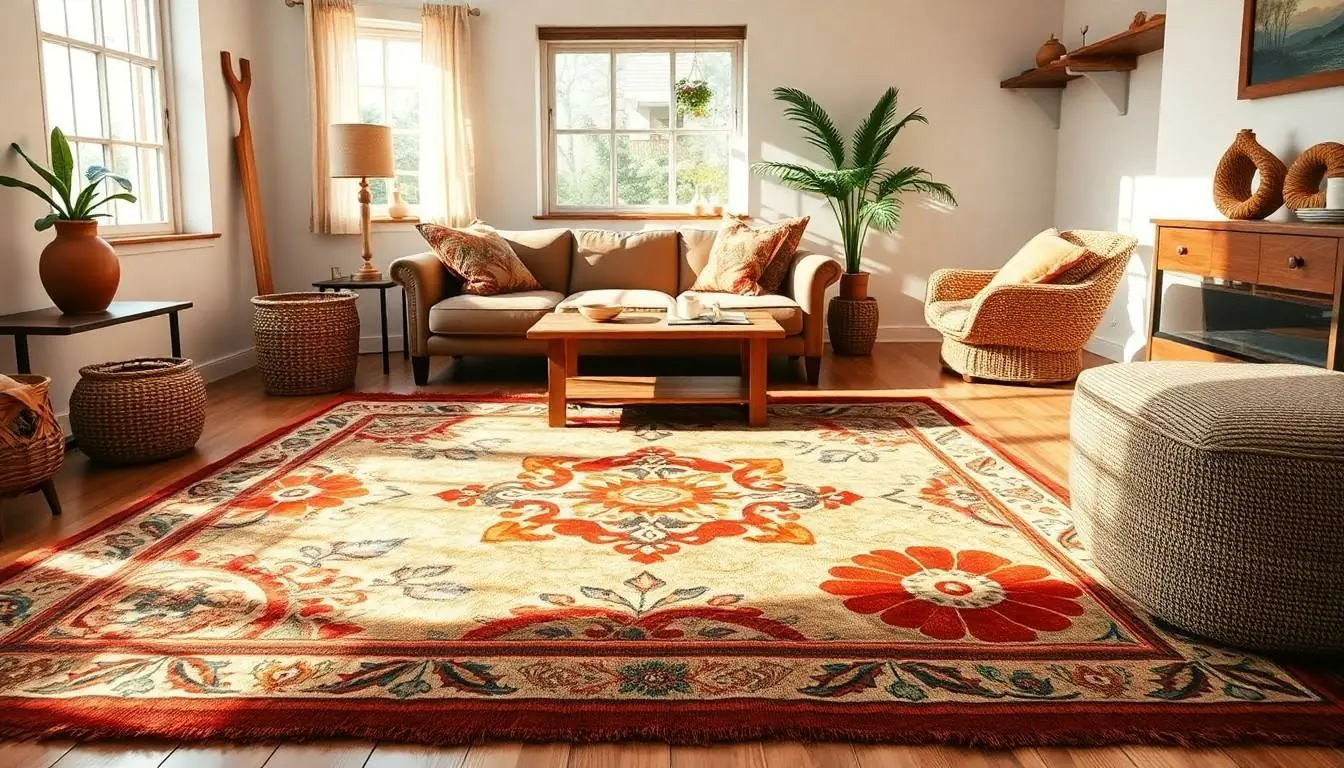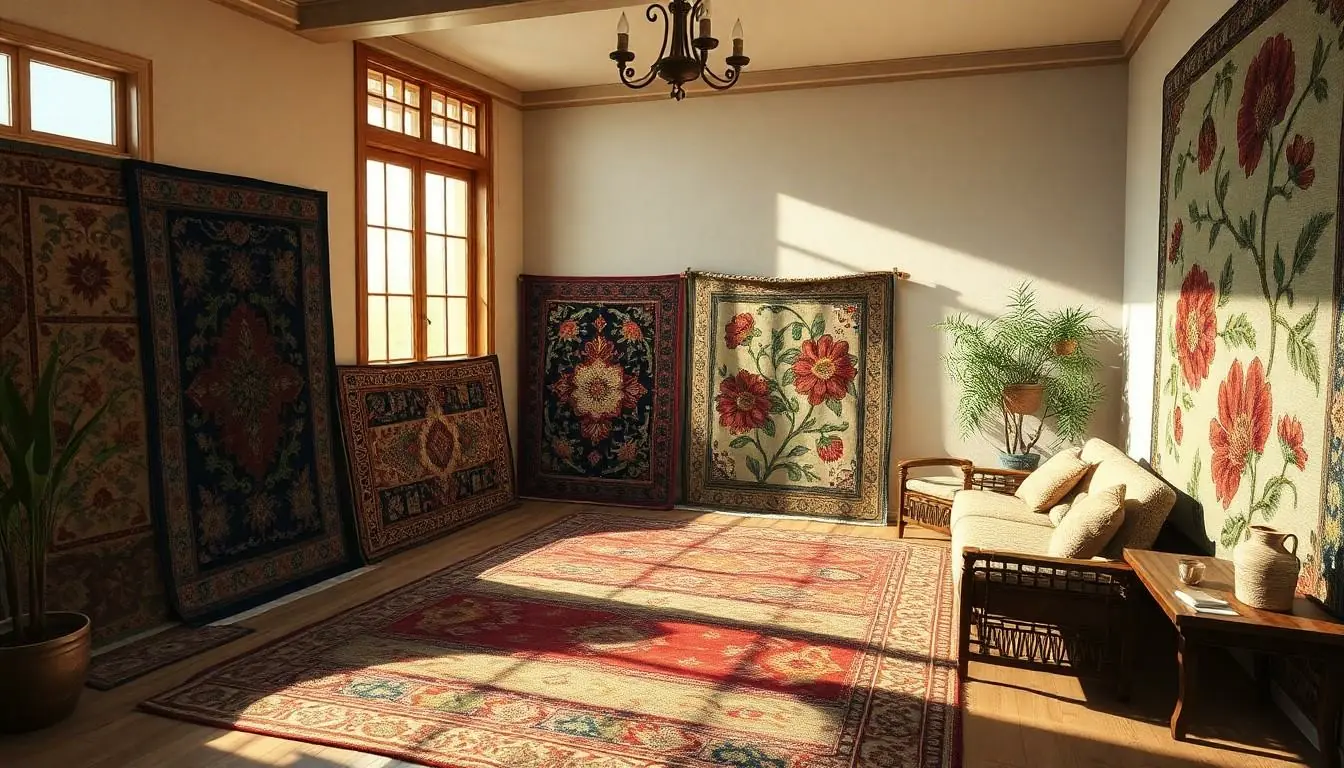When it comes to home decor, arts and crafts rugs are the unsung heroes that can transform any space from drab to fab. These vibrant pieces don’t just cover floors; they tell stories, spark conversations, and might even distract guests from that questionable stain on the couch. Who knew a rug could be the life of the party?
Imagine stepping onto a plush masterpiece that’s not only a feast for the eyes but also a warm hug for your toes. With endless designs and textures, arts and crafts rugs cater to every personality—from the whimsical dreamer to the sophisticated minimalist. So, why not let your floors join the fun? After all, a well-chosen rug can elevate a room and make it feel like home, one crafty stitch at a time.
Table of Contents
ToggleOverview of Arts and Crafts Rugs
Arts and crafts rugs represent a unique blend of functionality and artistic expression. These rugs often showcase intricate patterns and rich colors inspired by nature and handcrafted techniques. Each rug offers distinct textures and designs that reflect individual tastes.
Traditional weaving methods define many arts and crafts rugs. Wool, cotton, and jute serve as popular materials due to their durability and aesthetic appeal. Implementing these materials ensures that rugs maintain their beauty over time.
Cottage style often influences the design of these rugs. Bold geometric shapes and floral motifs frequently adorn the weaves, enhancing the overall ambiance of a room. Each design can provide visual interest while also complementing furniture and surroundings.
Regions known for arts and crafts design include the American Arts and Crafts Movement. This movement celebrated craftsmanship, emphasizing the value of handmade items. Many artisans create rugs in line with these principles, prioritizing quality over mass production.
Choosing an arts and crafts rug adds character to both modern and traditional homes. Such rugs not only serve decorative purposes but also offer emotional warmth. The colorful, inviting appearance of these pieces can transform any space into a cozy retreat.
Arts and crafts rugs play an essential role in home decor. Their unique designs and quality construction contribute significantly to a home’s atmosphere and visual appeal. Individual choice in style and color can further personalize any room.
Historical Context
Arts and crafts rugs carry a rich history that reflects cultural movements and artistic expressions over time. These rugs embody a dedication to craftsmanship and nature-driven designs, resulting in unique and vibrant home decor elements.
Origins of Arts and Crafts Movement
The Arts and Crafts Movement emerged in the late 19th century, primarily in Britain. It arose as a reaction against industrialization and mass production, emphasizing the value of handmade goods. Craftsmen sought to revive traditional techniques, merging functionality with aesthetic appeal. Key figures such as William Morris championed this approach, advocating for art that enriches everyday life. Their ideals influenced various artistic disciplines, including textiles and rugs. Thus, arts and crafts rugs began to reflect the movement’s philosophy, incorporating organic materials and natural patterns.
Evolution of Rug Designs
Rug designs have evolved significantly since the inception of the Arts and Crafts Movement. Early designs featured a focus on geometric patterns and floral motifs, inspired by nature. The use of traditional hand-weaving techniques has remained consistent, ensuring durability and craftsmanship. Over time, artisans began to experiment with new colors and textures, expanding the variety available to consumers. Contemporary designs now incorporate modern aesthetics while maintaining the essence of arts and crafts origins. As a result, today’s rugs appeal to various tastes, making them popular choices in both traditional and modern settings.
Characteristics of Arts and Crafts Rugs
Arts and crafts rugs possess distinctive features that set them apart in the realm of home decor. These characteristics emphasize both their aesthetic appeal and their connection to tradition.
Materials Used
Durable materials characterize arts and crafts rugs. Wool often serves as the primary fiber, providing warmth and resilience. Cotton complements wool, offering versatility and softness. Jute features prominently as an eco-friendly option, adding texture with a natural look. The use of these materials ensures longevity and ease of maintenance. Each material contributes to the overall quality of the rug, facilitating its role as a functional art piece in various settings.
Design Elements
Bold geometric shapes define the design elements found in arts and crafts rugs. Floral motifs frequently interlace within these patterns, reflecting nature’s beauty and influence. Color palettes often include rich earth tones and deep hues, enhancing visual warmth. The designs resonate with simplicity, mirroring the principles of the Arts and Crafts Movement. Intricate details emerge through handcrafted techniques, celebrating individual artistry. Each element unites to create a distinctive character for the rug, enriching the overall atmosphere of a space.
Popular Styles
Arts and crafts rugs come in various styles that celebrate both tradition and artistry.
Mission Style Rugs
Mission style rugs showcase a distinct aesthetic rooted in the Arts and Crafts Movement. Characterized by their simple, straight lines, these rugs emphasize handcrafted quality. Often made from natural materials, they feature warm earth tones reflecting the beauty of nature. Patterns typically include geometric shapes and understated floral designs, creating a serene ambiance. Mission style rugs add warmth and depth, enhancing both contemporary and classic interiors. Many homeowners appreciate these rugs for their ability to blend seamlessly with rustic furniture and decor.
Persian Influence
Persian influence can be seen in many arts and crafts rugs, bringing intricate designs and rich colors to the forefront. Traditional Persian motifs, including elaborate patterns and detailed borders, add a touch of sophistication. Rugs inspired by this style often showcase deep reds, blues, and golds, enhancing a room’s elegance. Artisans employ centuries-old techniques, ensuring each piece tells a story through its intricate craftsmanship. Homeowners frequently choose these rugs for their ability to serve as stunning focal points within a space. The combination of Persian artistry and arts and crafts principles creates a unique aesthetic that stands the test of time.
Care and Maintenance
Proper care and maintenance ensure arts and crafts rugs retain their beauty and functionality over time.
Cleaning Techniques
Regular vacuuming prevents dirt buildup. He or she can use a vacuum without a beater bar for gentle cleaning. Spot cleaning with mild detergent and water addresses stains quickly. Blotting the affected area helps lift the stain without damaging fibers. For deeper cleaning, professional rug cleaning services are recommended, as they utilize safe techniques tailored for delicate materials. Taking care of occasional spills promptly minimizes permanent damage.
Preventative Measures
Using a rug pad enhances durability and prevents slipping. It also minimizes wear and tear on the rug’s foundation. Additionally, rotating rugs every few months preserves even wear from foot traffic. Placing rugs away from direct sunlight protects colors from fading. Furthermore, avoiding high humidity areas prevents mold and mildew growth, significantly extending the rug’s life. Maintaining a regular maintenance schedule ensures prolonged beauty and functionality.
Conclusion
Arts and crafts rugs are more than just decorative elements; they embody a rich history and craftsmanship that elevate any living space. Their unique designs and durable materials make them a worthwhile investment for those seeking to enhance their home’s aesthetic. By incorporating these rugs, individuals not only add warmth and character but also celebrate the artistry inspired by nature and tradition. With proper care and maintenance, these rugs can continue to enrich homes for generations, making them timeless pieces that resonate with both history and modern style.





